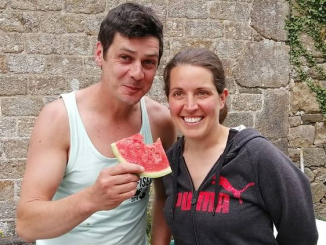Point of view | LEMONDE.FR | 27.02.12 |
by Jacques Berthelot, teacher and researcher in agricultural policies
Translation of the French version published by Le Monde ; also available on Solidarité website
The on-going negotiations on the reform of the Common Agricultural Policy (CAP) of the European Union (EU) were intensively debated at the Salon International de l’Agriculture in Paris, particularly the assets and weaknesses of French and European agriculture.

Official views present French agriculture as the largest food exporter in the EU and the second largest worldwide. Similar views are expressed in Brussels on the EU achievements, with the conclusion that France and the EU should promote a new CAP aiming at exporting more to reduce the food deficit of most developing countries (DCs), which would intensify up to 2050.
Yet, according to FAO, from 2000-09 France only ranked the 7th for the food trade surplus, fish included – after Brazil, the US, Argentina, the Netherlands, Australia and Canada –, whereas the EU faced an average deficit of $7.5 billion.
According to Eurostat, France had an average food trade surplus (fish included) of €10 billion from 2000 to 2010, with €40 billion of exports, 73 per cent of which were within the EU27, from which 77 per cent of its imports came.
However 97 per cent of its €4.1 billion surplus outside the EU have been made over the developed countries (including Russia) and 3 per cent only over DCs. But the surplus in beverages – of which 93 per cent are wines and spirits, which are not basic food staples – exceeded its surplus outside the EU by 6 per cent and, without wines and spirits, France would have had a food deficit of €1 billion with DCs. Therefore, before contemplating feeding developing countries, France should cease to be fed by them.
France’s food deficit with developing countries would have been much larger if its exports did not benefit from large subsidies, essentially domestic subsidies, as formal export refunds have almost disappeared. For instance cereals exports – another French asset with 31.5 million tonnes on average from 2000 to 2010, of which 10 outside the EU –, benefitted from specific subsidies of €61 per tonne in 2006.
And, if France has largely led in the EU for the agricultural production value from 2008 to 2010, particularly over Germany, Italy and Spain, it is this one that has largely headed for the net agricultural income per full-time agricultural worker – €18,305 against €12,605 for France –, although Spain was the last of the four countries for the agricultural production value. Indeed the weight of intermediate consumption in the agricultural production value is much higher in France (62 per cent) and Germany (68 per cent) than in Spain (43 per cent), which reveals intensive production systems.
Xavier Beulin, chairman of the leading agricultural union (FNSEA), should not lament that Germany overtook France by a tiny margin for the average value of food exports from 2008 to 2010. Germany had the largest deficit in the EU (€12 billion) against a surplus of €8.8 billion for France. France itself was outclassed by the Netherlands which enjoyed both the largest exports (€52 billion) and surplus (€15 billion).
As for the EU27, from 2000 to 2010, its food deficit reached €16.8 billion on average, fish included or €5 billion without fish. Those deficits would have been much larger without the €10.7 billion in net exports of beverages, essentially wines and spirits, which have almost compensated the €12 billion deficit on the 58.7 million tonnes imports of feedstuffs plus oilseeds plus vegetable oils and fats.
The EU27 agricultural deficit is significantly larger if we exclude the 10.6 per cent of agricultural exports, of €6.3 billion on average made under the “inward processing” regime from 2000 to 2009 from €1.5 billion of agricultural products imported duty free, as long as the processed products are re-exported. This regime deprived the EU farmers from significant outlets in their domestic market and is comparable to an internal social dumping against the EU farmers.
As the EU had an average food trade surplus of €17.4 billion over the developed countries from 2001 to 2010, of which €11.9 billion over Western countries and €5.5 billion over Russia, the end result is that they are the DCs which have brought to the EU an average structural food aid of €34 billion. Again, before contemplating feeding DCs, the EU should cease to be fed by them.
Nevertheless om average the EU27 exported €33.6 billion of food products to DCs from 2000 to 2010, €10 billion more than to developed countries. But those exports would not have been possible without considerable dumping. Thus, taking only the specific subsidies into account, including on feedstuffs, the exported meats received on average, from 2006 to 2008, per tonne of carcass-equivalent, €285 for pig meat, €288 for poultry meat and eggs and €1026 for bovine meat, the exported dairy products received €109 per tonne of milk-equivalent.
Furthermore, the large gap between the direct payments received by the EU15 farmers – an average of €282 per hectare in 2009 – and those received by their colleagues of the 12 new Member States (EU12) – an average of €85 in 2009 – has implied an EU27 internal dumping of €1.2 billion, or of 34%, on the EU15 net food exports of €3.5 billion to the EU12. This annual dumping of €1.2 billion on the EU12 is to be compared with the about €670 million of additional direct payments for the EU12 in 2020 implied by the European Commission’s proposal of 12 October 2011 for a partial convergence between the levels of direct aids in the EU15 and EU12. Besides, the competitive edge of the EU15 over the EU12 due to this gap in the level of per hectare direct payments has had a parallel import substitution effect whereby the EU15 has imported less from the EU12 than it would have done with equal per hectare direct payments.
In view of the EU27 structural food deficit, the prevailing discourse in France and the EU is that the EU should put higher tariffs on food imports coming from countries not constrained by the same environmental and social norms, the implicit corollary being that the EU should not tax the food imports from countries with the same norms. This discourse is very dangerous as it would imply importing the €15.5 billion of food products duty free which on average between 2001 and 2010 came from Western countries which abide roughly by the same norms. Because they are these countries which face the highest tariffs as those on DCs are low or nil. This would strongly increase the EU food deficit, accelerating the losses of agricultural employments and all the beneficial effects of a peasant agriculture on agro-ecological production systems, town and country planning, and animal welfare.
The EU official strategy at the WTO and in its on-going negotiations of bilateral agreements – particularly with Mercosur, India and ACP (Africa, Caribbean and Pacific countries) for the EPAs (Economic Partnership Agreements) – is absurd as it consists of lower its agricultural tariffs in exchange for an increased access to the DCs’ markets of non-agricultural products and services. To the contrary the EU should promote at the WTO and in its bilateral agreements to rebuild all agricultural policies on food sovereignty: the right and even the duty of each large region in the world to build its agricultural policy on an efficient import protection to ensure agricultural incomes based on stable and remunerative prices. In return all types of dumping should be forbidden, including that hidden in allegedly decoupled domestic subsidies benefitting exported products.
Indeed the survival of the EU27 farmers is linked to their domestic market on which from 2006 to 2008 they sold 84.5 per cent of their unprocessed food products. This is also true for the EU agro-industries which have sold 75.1 per cent of their processed food products on the EU domestic market. If the Doha Round would eventually be concluded on the basis of the WTO Draft modalities on agriculture from 6th December 2008 prescribing an average cut of 54 per cent in the agricultural tariffs of developed countries, and 75 per cent for tariffs above 70 per cent, the EU agro-industries would no longer be competitive and would disappear, the more so if an agreement with Mercosur were to be concluded.





